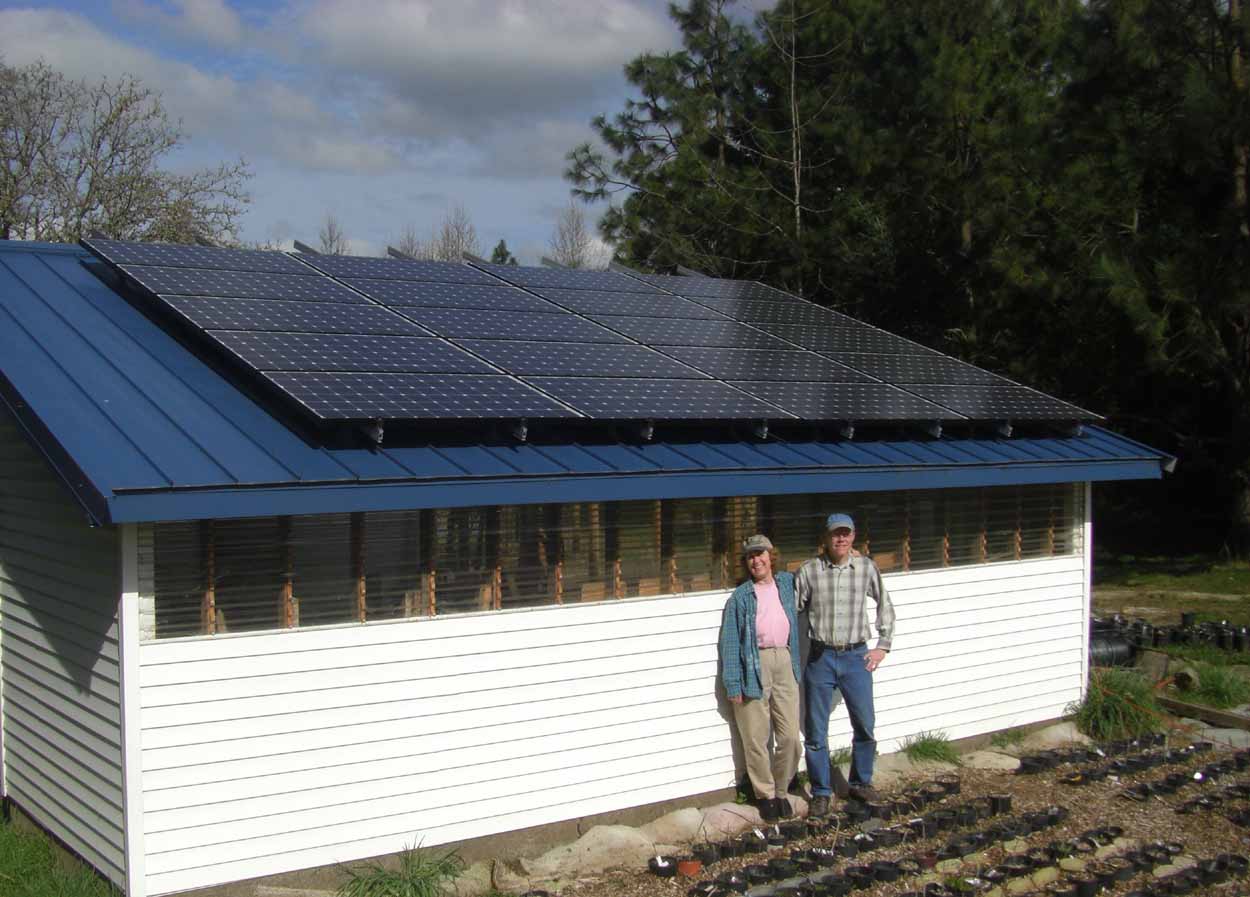
We were pleased with the work, and are also pleased with the resulting energy generation.
See prices and excerpts from contract below.

|
Return to Home Page We were pleased with the work, and are also pleased with the resulting energy generation. See prices and excerpts from contract below. |
|
|
|
We were at the County Fair to answer questions at the Grange (Patrons of Husbandry) display. This is Kinton Grange's. It won 3rd prize. Joe is an electrical engineer, works as an Electrical Design Manager and keeps himself informed on things electrical...including photovoltaic developments. As well as being Grange Master, I am an environmentalist and am always pushing for conservation and efficiency, and appropriate technologies. |

|
October 15 our panels were delivered; 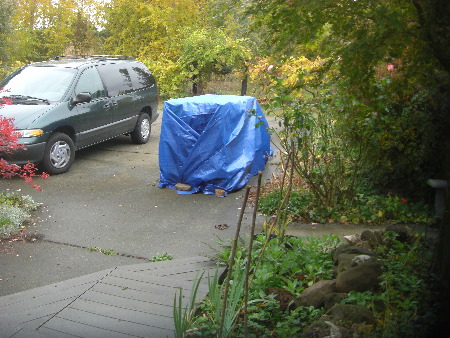
|
By the 19th they were stacked under the roof of the tractor barn. 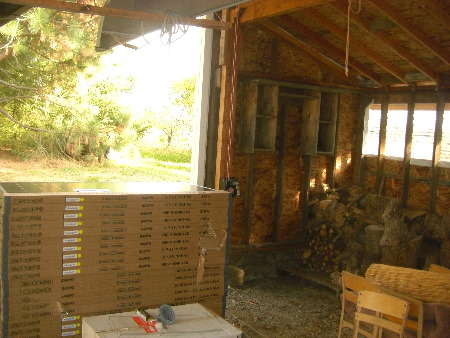
|
|
Close up of 20 panels; 210 watts each. Sanyo HIP-210NKHA5 
|
The Roof of the Tractor Barn on Oct 19: Unirac mounting system installed.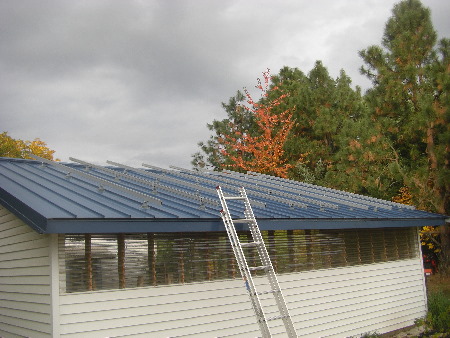
|
|
|
|
Floor of the Tractor barn, contents of box installed on wall. 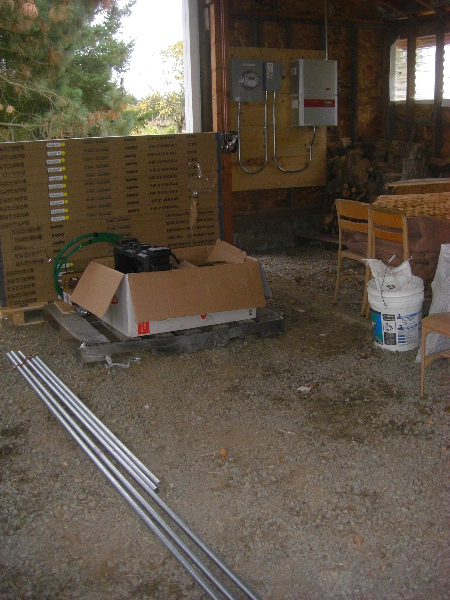
|
This project went so fast! Never have I had work done so well and so fast. Of course, I've never spent this much money on a project before either... Fortunately there were great tax credits and assistance from the Energy Trust too. So far, everything has worked out as predicted -- Financially and in power generated. Initial Cost $34,783.00 Energy Trust Incentive -$9,450.00 State Tax Credits -$6,000.00 Federal Tax Credits -$7,600.00 Additional Federal Tax Liability Due to State Tax Credit +$2,100.00 Potential Net Cost $13,833.00 (Up front, out-of-pocket expense, was about $25,000. Federal tax credit received in the first year. State credits are spread over 4 years.) Power rating for the system is 4200 Watts. By the time it goes through the Fronius inverter at an 80-85% efficiency, we should be generating 4000kW hours (4 MegaWatt hours) per year We have seen 3800+ Watts being generated, but this is not necesarily the highest. While discussing prices, it should be noted that the cost of a college education these days produces somewhat comparable numbers. Our final cost is not too dissimilar from the annual cost of going to a 4 year state university. While money on education is always well spent, it sometimes takes a while to recover the investment. We figure this is true with the PV investment also, with a bit more assurance that the end result will be tangible. And, like education, the financial return is not the only value received. |
|
|
Meter in the tractor barn.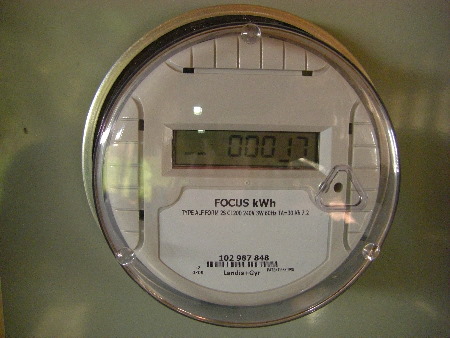
|
The Panels in place October 28, 2009.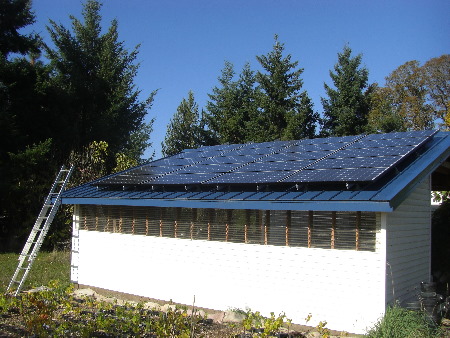
|
|
|
|
New Meter PGE installed on the house. November 1, 2009
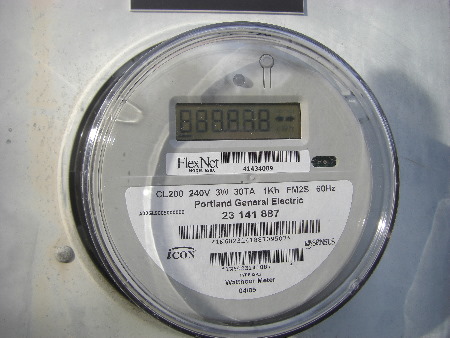
|
It doesn't really reverse, but keeps track of incoming and outgoing KWh.
"Tax incentives" are NOT "Feed in Tariffs". Total cost of the system was just under $35,000. The Oregon Energy trust paid up front for a bit less than a third of the system, and tax credits (over the next 4 years) will recover another third. The remaining out of pocket expenses will take 15 years to recover if the price of energy doubles in the next 15 years. (A likely scenario.) The 20 Sanyo PV panels and the Fronius inverter have 25 year and 10 year warrenties, respectively. One of the things Joe learned: PV's don't operate at their best when the temperature is very high. Thus, while PV energy output in Oregon might seem to be minimal compared to Arizona, it actually compares pretty well. The increased quantity of sunshine in the southwest desert is negatively offset by the increased temperatures. |
|
|
|
|
We have been recording numbers a couple of times a week to monitor the system
and are pleased. We have an Excel spreadsheet where we insert our incoming and outgoing KWh, and also the total number we are generating out on the Tractor Barn roof. Almost every day, even in the depths of winter, we've had peak periods when we generated more than we were able to use at the time. We have also tracked our cumulative use, starting last November when the system was turned on. We dropped to about 10% of our total cumulative use in January, and have been steadily increasing since then as the sun shines longer and at a better angle (and with fewer clouds) each day. Our PV installation (as of May 1, 2010) has now generated over 20% of all of our use since it was installed. We were told with this size system and our use patterns we would likely generate about a third of our current use (about 12,000 Kwh/year). With a heat pump for our space heating (installed 25 year ago) we are already fairly efficient. |
Feb 28, 2010.
|
Excerpted from our contract with Sustainable Solutions Unlimited (or, What we got for our money)SCOPE OF SERVICES:Solar Design and Application Processing-- Sustainable Solutions Unlimited will provide design and project management services for a 4.2kW solar residential installation including: Solar Installation, Commissioning, and Testing-- Provide construction, electrical permitting, and project management services to install a 4.2kW solar electric installation, including: All work listed above will be performed according to Energy Trust of Oregon specifications. Sustainable Solutions Unlimited and all of its subcontractors are licensed by the Oregon Construction Contractors Board, bonded, and covered by workman&srquo;s compensation insurance. Again, we are pleased with the results. Return to Home Page |
|
"Up front cost" answers the guy from PGE....the man who is asking how we feel about paying $500 Million for PGE to modify the Boardman Coal Burning Plant that currently generates a bunch of our electricity. Plus there is the cost of a Natural Gas Burning Plant PGE wants to build, though they won't until the PUC approves it*. But he doesn't seem to think solar roofs (distributed generation) are much of a contributor as energy suppliers. I think PGE doesn't want to lose control of the market; but wants to continue to grow and build big power plants. I appreciate the grid--the stability and backup it provides--but it seems like generating 20-40% of our electricity on local residential and commercial roofs, would be a better use of that half billion dollars PGE is preparing to spend on upgrading Boardman so we can keep it working longer and ~~continue to mine and burn coal! |
Generating our own to reduce our impact on the planet. Between our high quality inverter and the short distance our home generated electicity has to travel, our system is very efficient and our short feedback loop provides additional incentive to conserve. Individual PV installations don't need "economies of scale" to be worthwhile. How many of my readers assisted their children or grandchildren with their college expenses? If you were able to, you did so because it seemed (at least at the time) to be a good investment. ~~ An investment in their future. This major investment also seems like a good investment in their future. |
* PGE representative (at WC Public Affairs Forum, May 17, 2010) told us that unless the PUC approves their plan [for modifying Boardman or building any new generating plants] -- eg. approves the necessity for the plan and its implimentation -- that they run the risk of not receiving the PUC's permission to pass the cost of construction onto the ratepayers. Not a risk PGE seems likely to take.
Knowing where your energy comes from is like knowing where your food comes from. Humm..? Food is energy.... |